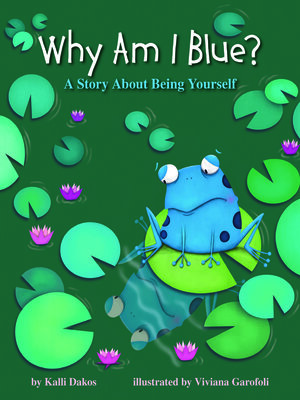
Sign up to save your library
With an OverDrive account, you can save your favorite libraries for at-a-glance information about availability. Find out more about OverDrive accounts.
Find this title in Libby, the library reading app by OverDrive.



Search for a digital library with this title
Title found at these libraries:
| Loading... |
The Blue Frog looked at his reflection in the water and asked, "Why am I blue?"
The Green Frog didn't know.
Dandelion had no answer.
And Fish? No idea either!
Being different from one's peers can be hard. We all want to be part of a group and to be accepted and loved by others. We might struggle with whether to embrace our differences or hide them in order to fit in.
In this story, the Blue Frog wonders why he is blue, and not green like other frogs. He feels confused, sad, and different, and seeks to answer the question "why am I blue?" Eventually hearing a simple, but profound explanation, the Blue Frog begins to embrace his blueness and accept being different than his friends.
Includes a Note to Parents and Caregivers by Gayle E. Pitman, PhD, that discusses how children experience differences throughout childhood and how adults can guide children toward an understanding and acceptance of differences and similarities they will face throughout life.
From the Note to Parents and Caregivers:
Some differences can be a source of positive self-esteem for children. They could have qualities that are cool, quirky, and respected by others. For example, if a child is especially talented at something, like art, music, or athletics, they might feel respected by their peers, even though their talent sets them apart to some extent. Moreover, if this quality is nurtured by family members and teachers and through extracurricular activities, these differences can enhance self-esteem in a powerful way.
Differences don't always work that way, though. Some differences involve characteristics like disability, gender identity, or race, qualities that have been used throughout history to justify inequality and mistreatment. If differences aren't valued by the individual or by society, a few things can happen...
The Green Frog didn't know.
Dandelion had no answer.
And Fish? No idea either!
Being different from one's peers can be hard. We all want to be part of a group and to be accepted and loved by others. We might struggle with whether to embrace our differences or hide them in order to fit in.
In this story, the Blue Frog wonders why he is blue, and not green like other frogs. He feels confused, sad, and different, and seeks to answer the question "why am I blue?" Eventually hearing a simple, but profound explanation, the Blue Frog begins to embrace his blueness and accept being different than his friends.
Includes a Note to Parents and Caregivers by Gayle E. Pitman, PhD, that discusses how children experience differences throughout childhood and how adults can guide children toward an understanding and acceptance of differences and similarities they will face throughout life.
From the Note to Parents and Caregivers:
Some differences can be a source of positive self-esteem for children. They could have qualities that are cool, quirky, and respected by others. For example, if a child is especially talented at something, like art, music, or athletics, they might feel respected by their peers, even though their talent sets them apart to some extent. Moreover, if this quality is nurtured by family members and teachers and through extracurricular activities, these differences can enhance self-esteem in a powerful way.
Differences don't always work that way, though. Some differences involve characteristics like disability, gender identity, or race, qualities that have been used throughout history to justify inequality and mistreatment. If differences aren't valued by the individual or by society, a few things can happen...






